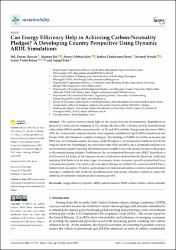Can Energy Efficiency Help in Achieving Carbon-Neutrality Pledges? A Developing Country Perspective Using Dynamic ARDL Simulations

Göster/
Tarih
2022Yazar
Hossain, Md. EmranRej, Soumen
Saha, Sourav Mohan
Onwe, Joshua Chukwuma
Nwulu, Nnamdi
Bekun, Festus Victor
Taha, Amjad
Üst veri
Tüm öğe kaydını gösterÖzet
The current research sheds light on the nexus between environmental degradation as
proxied by carbon dioxide emissions (CO2
), energy efficiency (EE), economic growth, manufacturing
value-added (MVA), and the interaction effect of EE and MVA in India. Using yearly data from 1980 to
2019, the current study employs dynamic auto-regressive distribution lag (DARDL) simulations and
Fourier Toda and Yamamoto causality techniques. The findings of DARDL reveal that as income and
MVA rise, environmental quality decreases, while EE improves environmental conditions in both the
long and short run. Surprisingly, the interaction term of EE and MVA has a detrimental influence on
environmental quality, meaning that India remains unable to provide energy savings technologies
to the manufacturing industry. Furthermore, the environmental Kuznets curve (EKC) hypothesis is
well-founded for India, as the long-run income coefficient is smaller than the short-run coefficient,
implying that India is in its scale stage of economy, where economic growth is prioritized over
environmental quality. The results of the causality technique reveal that CO2 emissions and EE have a
bidirectional association. Therefore, policymakers in India should embrace realistic industrialization
strategies combined with moderate decarbonization and energy efficiency initiatives under the
umbrella of sustainable industrial and economic growth.
Cilt
14Sayı
13Bağlantı
https://hdl.handle.net/11363/6120Koleksiyonlar
Aşağıdaki lisans dosyası bu öğe ile ilişkilidir:

















